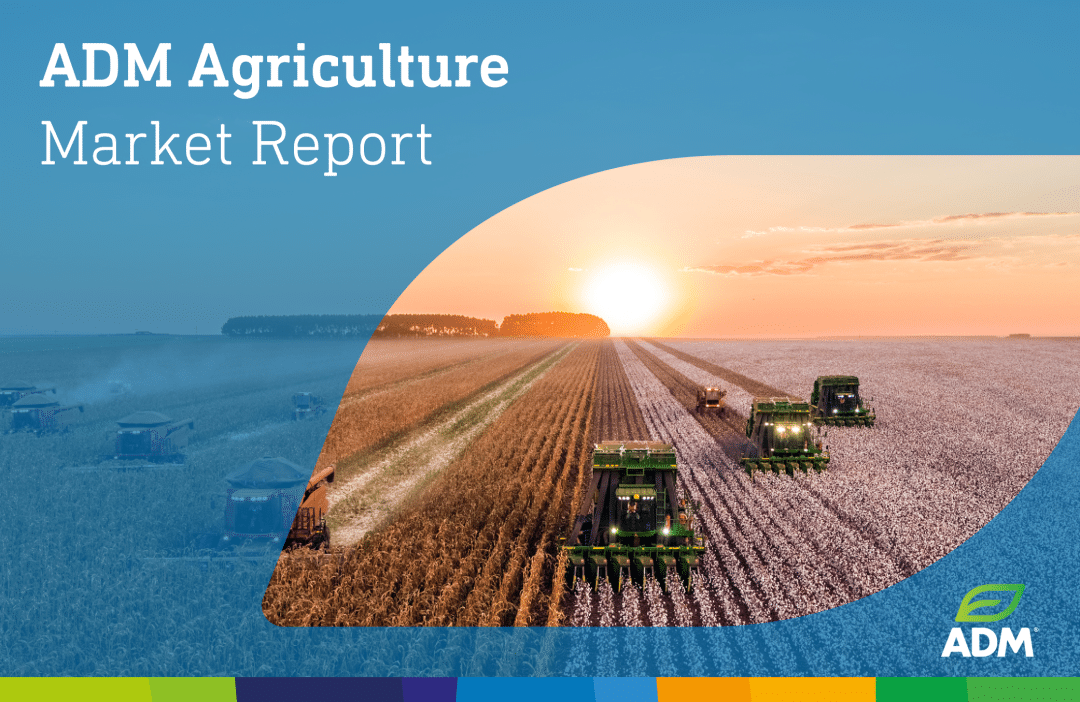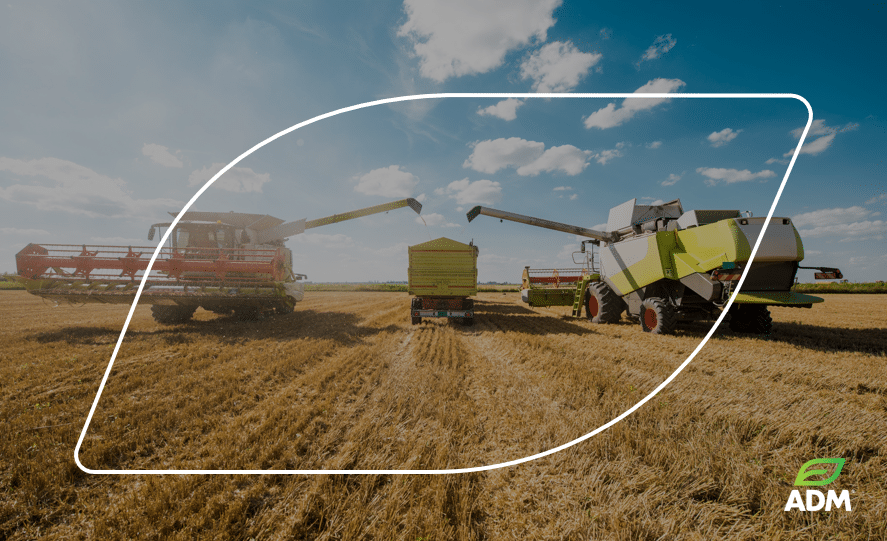WELCOME TO THE ADM AGRICULTURE WEEKLY MARKET REPORT
Wheat
- Another week of lower prices after last week’s bearish USDA report and a less-threatening weather outlook set the market tone. Chicago wheat has traded down 25c w/w, or $9/t over the week.
- Despite weekly exports showing an improvement last week, and notification of Chinese shipments, overall exports are still running 18% lower y/y, at 11.71mln t. With continued weakness in the corn market (trading at a 3-year low), talk of an increased Russian export quota, and lacklustre international demand ahead of domestic harvests, prices should remain on the defensive.
- European prices have followed the global trend, trading down €6.25/t. Despite this, Russia’s Ag Ministry has proposed to raise the quota on grain exports in 2024 to 28mln t, up from the current 24mln t.
- Ukraine’s Ag Ministry expects 2024 spring sowing area to be the same as last year, with corn and oilseeds being the dominant crops, while France’s Ag Ministry placed 2024 winter-grain plantings down 7.5% y/y, with wheat at 4.4mln ha, down 7.7%
- Strategie Grains, have again lowered their projection for this season’s EU soft wheat crop to 125.8mln t, down 0.2mln t m/m, but downward adjustments in usage and exports kept the carry-out unchanged at 13.6mln t.
- The UK market is still moving lower, down another £5.50/t w/w, and is now a staggering £32/t, or 16% weaker than at the start of 2024. Despite a fall in sterling, as data showed that the UK economy fell into recession at the end of 2023, it is doing little to support farm-gate prices, as producer selling continues at a pace that gives enough liquidity to allow London futures to weaken by the day.
- In summary, the market, especially for old crop, isn’t short of wheat, and even the move to lower values isn’t stimulating any significant increase in demand. As the weeks pass, domestic harvests near, providing less urgency for key importers to extend coverage. The 2024 harvest outlook in both the UK and EU looks challenging, but any support that this brings is currently being outweighed by the overall fundamental weakness overhanging this season’s grain markets.
Malting Barley
- Malting barley prices have come under further pressure this week. With no demand to speak of and the feed base price under pressure, prices continue to drift lower.
- New crop values are down again on the week, following the same theme as old crop with low demand and a very relaxed feeling on production, support is not there and prices are down again on the week.
- All eyes will be closely following plantings and weather.
Feed Barley
- Feed barley continues to come under pressure from falling futures and lack of physical cash market demand.
- Export business has been written in recent weeks, but corn continues to be the cheaper option at destination.
- New crop barley is also continuing a bearish tone, with basis holding out at a significant discount to wheat.
- Overall barley remains heavily discounted on both crop season despite seasonally subdued farmer selling.
Rapeseed
- Soybeans trade lower this week, with Argentinian crop conditions improving. Last week’s USDA report posted a bearish picture once again, however, the trade refrained from reacting for the time being. The main focus, going onto the report, was South American production, where the Brazilian soybean crop was only reduced 1mln t to 156mln t, compared to an expected 153.15mln t. In Argentina, production was unchanged at 50mln t vs. 50.84mln t. World ending stocks were the main surprise, being increased from 114.60 billion bushels to 116 billion bushels compared to an average estimate of 112.48, and US ending stocks were increased from 280 million bushels to 315 vs an expected 284.
- Since the report, Argentina has started to receive much-needed relief in the form of increased precipitation, which has led to Rosario increasing the expected yield indicating a production of 52mln t. Brazil, however, has seen a turn for the worse in the weather and could have lost up to 100,000 Ha of crop. Crop conditions are lower this week, with 31% good/excellent compared to 36% last week. Production estimates are getting closer to 149mln t.
- Energy markets have been mixed this week as crude has attempted and failed to make a new high following another rise in weekly US crude oil stocks, rising 5.520 million barrels to now sit 17.243 million barrels below the 5-year average. Imports for the week were 1.302 million barrels per day higher at 6.907. The refinery operating rate was 0.5% lower at 82.4%. OPEC’s February oil market report kept 24 and 25 world demand growth unchanged and raised economic growth forecasts for both years.
- Veg oils are mixed this week, as soy oil tried to bounce from contract lows but failed. Palm oil on the other hand is higher on the week, as Malaysian palm oil stocks for January fell 11.83% from December to 2.02mln t. Crude palm oil production reduced 9.59%, while exports only dropped 0.85%.
- Canola is lower this week as Canadian farmers continue to try and catch up on farmer selling after being 2mln t behind in December compared to the 5-year average. Canadian crushers still manage to find cheap seed from the Black Sea, bringing weekly canola crush to a record high of 228,309mt – the weekly crush rate has only surpassed 220,000mt five times.
- MATIF rapeseed is higher this week, after finding support at €410, and has run into resistance at €425. The market is now in need of a new story to push prices back to nearby highs. In the short term, prices continue to trade in a downtrend.
- Sterling trades at 1.16900.
Oats
- Oat markets continue to be supported by the overall tightness in Europe. Consequentially, prices are not falling in the same way as other grains like wheat and barley.
- Canadian oats look well priced to be imported into Europe, however the volume of this trade flow depends on whether the origin is accepted by EU retailers.
- The differential between feed oats and wheat continues to be exceptionally high and could see reductions in demand with consumers switching to cheaper substitutes.
- The UK milling oat market remains one of the most expensive in the world and this could have an impact on demand in the months to come.
- Millers remain buyers for Mar’24 onward positions, but if supply remains unforthcoming, we could see Canadian oats feature come mid-spring.
- New crop prospects in the UK remain a flag of concern given that so little of the spring crop has been planted. Quality and quantity downgrades historically will start to reduce if crops are not planted in the next two weeks, and this could lead to a greater proportion of feed oats.
- Bottom line, oat markets are holding up far better than any other in the grains complex, and with a minimal carry into 2024/25, all eyes will be on the development of the new crop.
Pulses
Beans
- Another week of consumer bids drifting lower, primarily on the East Coast, as beans finally start to try and compete in the ration, especially for the summer diet. Despite this, beans still look too expensive to compete against the more aggressively priced proteins and cereals. We are starting to show signs of the bean price correcting, and we are starting to see the early signs of an increase in domestic demand as a result. There is still more work to do, however, with the falling value of GBP vs both EUR and USD, this will help temper the scale of the move required by beans slightly. The main takeaway from this is beans are starting their attempt to become more relevant once again within the mainstream domestic compound ration.
- The international markets have seen another week of geo-political volatility and instability. With Ramadan approaching, the focus will be on the Middle East, and especially Egypt from a faba bean perspective. The economic situation in one of the world’s largest consumers of faba beans continues to remain tense, with significantly reduced revenues from lower Suez transits adding to the economic woes.
- With February marching on, the weather continues to offer a mixed bag. The long-term forecast is showing some rainfall in the 4–7 day slot, although temperatures are also forecast to be warmer than normal for this time of year, which should help offset some of the excess moisture for those trying to drill. Whilst avoiding unnecessary soil compaction is important to seeing good establishment in beans, those that have drilled early in recent seasons have typically seen better yields at harvest. For those with questions about how best to get your beans established, contact your farm rep and they can share the advice from the PGRO, including considerations around drilling winter beans in the spring window.
Peas
- Feed peas continue to be in strong demand nationally. Supply issues are leaving consumers short across the UK, leading to high ex-farm prices, which have again risen week on week.
- From a human consumption perspective, green peas remain in extremely high demand due to the ongoing import duty situation across in India. Prices are pushing towards the £400/t delivered mark on farm for good quality with low bleaching. Please get in touch with your farm trader if you have any open market parcels!
- Our 2024 buybacks are becoming tighter on marrowfats and large blues, with seed availability dwindling. Please get in touch to avoid disappointment. We are still available to offer pre-February movement. Yellow peas are firmly available to those who would like a lower-risk spring cropping option.
Seed
- We have spring pea seed available for prompt delivery to go alongside our market leading buybacks.
- As we begin to look towards the 2024 autumn drilling campaign, there are some excellent varieties to choose from, including newly recommended group 3 soft wheat Bamford, which looks set to reinvigorate the group 3 market, yielding on par with the highest-yielding feed wheats and boasting the best Septoria resistance across all recommended soft wheats.
- We would advise those planning their rotations to cover seed requirements sooner rather than later for autumn drilling. Due to the extreme weather conditions causing issues with autumn 2023 drilling, seed crop area and yields are predicted to be down, therefore we expect seed supply to be limited across all mainstream varieties this coming year.
- The Sustainable Farming Incentive is a huge talking point at the moment. Since the rollout of the new schemes, applications have continued to rise. At ADM we have a range of mixes available to suit the various scheme requirements. Whether it’s winter bird feed to a nectar flower mix, ADM has a mix for you!
Fertiliser
- North African granular urea appears under pressure at present as March shipment demand appears minimal in Europe. Weather and crop output prices are weighing on demand.
- US interest is reportedly increasing though which could support North African prices for March. Australian demand had supported prices east of the Suez at the end of last week into the beginning of this week.
- Nitram delivery windows have changed to full month April, and full month May is now available, giving options to those looking for later applications on grassland or late bag milling wheat applications.
- Imported AN still carries a premium in the spot market, and inhibited urea makes economic sense for those needing March delivery for April applications.
- Liquid UAN prices remain relatively static as UK prices have remained under replacement values, but some late demand in the UK could support spring fill. This is despite recent weakness in global markets which are bringing it more in line with UK values once again.
- N18 offers for milling wheat applications also are on offer from ADM at present.
- MOP prices remain available from ADM and demand has increased, DAP and TSP demand is also increasing, and ADM can offer 0PK, NPK and straight prices for immediate delivery.
| £/€ | £/$ | €/$ |
|---|---|---|
| 1.1670 | 1.2565 | 1.0765 |
| Feed Barley £ | Wheat £ | Beans £ | Oilseed Rape £ | |
|---|---|---|---|---|
| Feb 2024 | 130-145 | 156-171 | 240-245 | 345-350 |
NB: Prices quoted are indicative only at the time of going to press and subject to location and quality.
“Although ADM Agriculture take steps to ensure the validity of all information contained within the ADM Agriculture Market Report, it makes no warranty as to the accuracy or completeness of such information. ADM Agriculture will have no liability or responsibility for the information or any action or failure to act based upon such information.”
ADM Agriculture cannot accept liability arising from errors or omissions in this publication.
ADM Agriculture trade under AIC contracts which incorporate the arbitration clause.
Terms and Conditions of Purchase.
On every occasion, without exception, grain and pulses will be bought by incorporating by reference the terms & conditions of the AIC No.1 Grain and Peas or Beans contract applicable on the date of the transaction. Also, we will always, and without exception, buy oilseed rape and linseed by incorporating by reference the terms & conditions of the respective terms of the FOSFA 26A and the FOSFA 9A contracts applicable on the date of the transaction. It is a condition of all such transactions that the seller is deemed to know, accept and understand the terms and conditions of each of the above contracts.



